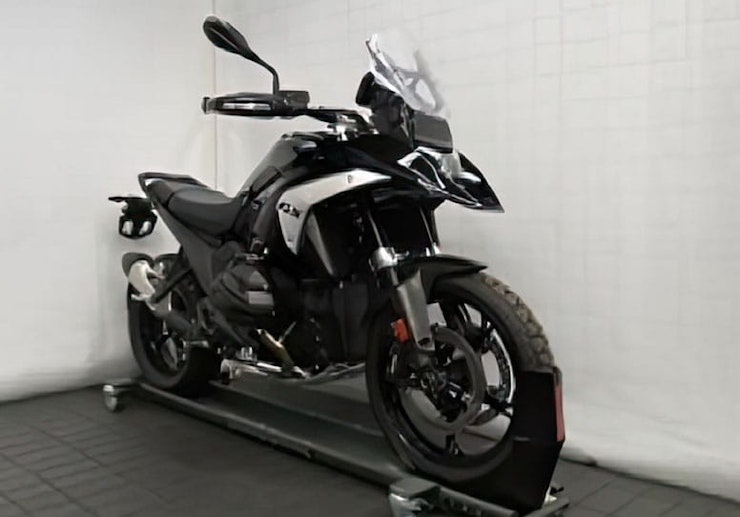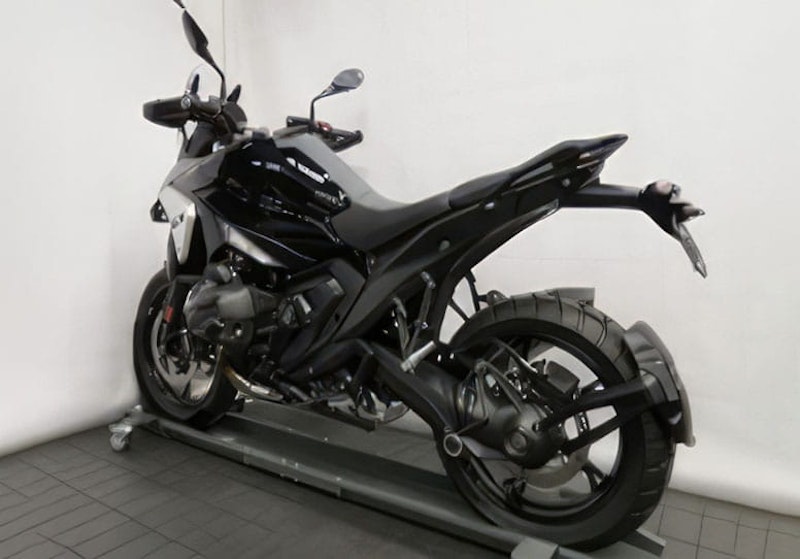2024 BMW R 1300 GS launch confirmed
By Ben Purvis
Motorcycle Journalist
10.05.2023
**Read the 2024 BMW R1300GS Review Here **
The existence of BMW’s R 1300 GS as a replacement for the best-selling R 1250 GS has been an open secret for months now as a growing number of prototypes get spotted on test around the world. Now BMW has confirmed the bike’s existence and given an official unveiling date.
The big GS, which is a nailed-on favourite to be Britian’s best-selling bike in 2024, taking over a crown its predecessors have held onto for the best part of two decades, will be presented in Berlin on 28th September 2023 as part of the 100th anniversary of BMW’s motorcycle division. It will be part of the opening ceremony of the BMW Motorrad Welt, a purpose-made museum facility adjacent to the Berlin-Spandau factory that’s the heart the company’s motorcycle manufacturing.
The announcement of the unveiling was made to coincide with the production of the millionth boxer-engined GS, which rolled off the line on Tuesday 21 June 2023. The family started with the R 80 G/S in 1980, evolving through the R 100 GS, R 1100 GS, R 1150 GS, R 1200 GS and eventually the current R 1250 GS in 2019. There have also been various spin-offs over the years, like the smaller R 65 GS of the 1980s, turning into the R 80 GS and R 850 GS in the 90s before the F-series parallel twins took over that middleweight role. It was in 2004, though, that GS leapt to the top of the sales charts, sparked by the R 1150 GS’s use in Ewan McGregor and Charley Boorman’s Long Way Round TV series.
While multiple prototypes of the new R 1300 GS have been spied on test over the last few months, the pictures you see here are the first undisguised examples of the bike. Published as part of the R 1300 GS’s type-approval in Australia, they reveal for the first time the design of the headlight, which appears to ditch the Popeye squint of the last few generations in favour of a symmetrical LED design. That signature was originally adopted by necessity in 1999 with the launch of the R 1150 GS, replacing the rectangular single lamp of the earlier R 1100 GS. BMW’s then design boss, David Robb, created the offset headlight to make a more compact front end – the deep headlight bowl of the main lamp could slide in next to the bulging rear of the speedometer. Today, compact LED lights and flat-backed LCD instruments mean there’s no need for the style to continue beyond a family resemblance.
For the new GS, BMW has moved the headlight down, dropping it into the signature channel sliced into the upper surface of the ‘beak’ on the nose. The space above it is dominated by a flat, plastic panel that hides the standard-fit front radar, allowing the use of adaptive cruise control and accident mitigating auto-braking. There’s a second radar on the rear, mounted in a box above the number plate.
The original pictures in the Australian type-approval are extremely low-resolution and published in the incorrect aspect ratio, giving a flattened look. We’ve corrected that and run them through AI image enhancement which improves their appearance but also introduces a few surreal artifacts and distortions that won’t be present on the final bike.
It appears that the new headlight has an ‘X’ shaped design, with a central main LED – likely to include a cornering light facility – surrounded by four, splayed strips, presumably used as DRLs to give an instantly recognisable ‘face’ to the new GS.
Other elements revealed in the undisguised images are brushed alloy side panels sporting the ‘GS’ logo, with matching alloy elements inset into the hand guards.
We’ve already been able to reveal many secrets about the new GS, including its power and dimensions, thanks to type-approval documents published in Europe, but the Australian paperwork throws new light onto the R 1300 GS’s weight. The European paperwork suggested the new machine was 1kg heavier than the current, 249kg R 1250 GS, but use an approximate measurement system intended to account for the weight of a rider and luggage rather than a real-world measurement. The Australian paperwork gives a more straightforward weight of 237kg for the 2024 bike, 12 kilos lighter than the existing model. That seems to make sense, given the R 1300 GS also features a completely new chassis around its reworked, ShiftCam boxer engine. That engine measures in at precisely 1300cc, up from 1254cc for the current model, and makes 107kW (143.5bhp) at 7,750rpm, compared to 100kW (134.1bhp) at the same revs from the current R 1250 GS.
This is what we’ve previously said about the bike:
Original Article: 31st May 2023
Since its predecessors have dominated the sales charts for nearly two decades the all-new BMW R 1300 GS is without doubt the most important new motorcycle set for launch this year – and now we’ve finally got the first technical details thanks to type-approval paperwork filed in Europe.
Codenamed GG13, the new R 1300 GS’s name is confirmed by the documents, which show it confirms to the so-called ‘Euro 5’ rules set out in under EU Regulation 168/2013. Published in Switzerland and the EU, the paperwork includes key technical data such as the bike’s power, torque and dimensions.
Where previous model changes for the R-series GS have tended to be incremental, the R 1300 GS is genuinely a new model, carrying over only its essential layout from its predecessors. There’s still a boxer twin engine, but it now clocks in at precisely 1300cc, up from the previous 1254cc, and earns a new code number – A75B13A – to replace the previous A74B12M used in the current, ShiftCam-equipped R 1250 GS.
The combination of air and liquid cooling is expected to remain, as is the ShiftCam variable valve timing system, but peak power rises from the R 1250 GS’s 134hp (100kW, 136PS) to 143.5hp (107kW, 145.5PS). The power peak still comes at 7,750rpm but maximum torque, up 5lb-ft to 110lb-ft (143Nm), arrives 250rpm higher than before at 6,500rpm. Top speed is 140mph (225km/h), up from 136mph (219km/h).
A second, restricted version of the bike, codenamed GG13R, has also been approved in Europe, with around 105hp.
The approvals show that there will be two exhaust systems offered with the R 1300 GS, a standard one with a single end can and an optional one with two silencers. Spy shots have shown bikes fitted with stacked Akrapovič silencers, which are likely to be the option versions.
The engine will be bolted to a completely new frame and one that, for the first time, steps away from the tubular trellis design that’s been used on every boxer-powered GS model since the bike’s inception.
Spy images show that the frame is largely hidden, but the handful of visible elements have the appearance of cast alloy parts. That might be deceiving, though, as BMW has previously been firmly in favour of steel for its GS models, and on the latest F-series twins uses a pressed-steel chassis that looks very much like an aluminium frame. Steel is more forgiving for off-road use, surviving flex without cracking and standing up to fatigue better than aluminium.
As on previous bikes, the front suspension uses BMW’s Telelever system and the rear end has a Paralever single-sided swingarm and shaft drive.
The approval documents show that the new GS is larger than the old model, even though it appears more compact in some spy pictures. It’s 5mm longer at 2212mm, and a full 105mm broader at exactly 1000mm across its bars. Three different heights are listed, reflecting either an adjustable screen or possibly adjustable-height suspension. The lowest gives a top-of-the-screen height of 1376mm, the middle position is 1406mm, the highest is 1426mm.
As on the current GS, the wheels are 19in at the front, 17in at the rear, with 120/70-19 front and 170/70-17 rear rubber. Cast alloy and wire wheel options will be offered.
Technology is going to be a big selling point for the new GS, and the headline features will include both front and rear radars, allowing it to adopt adaptive cruise control, blind-spot monitoring and rear collision warning features.
Unlike the first generation of radar-equipped motorcycles, including BMW’s own R 1250 RT, the front radar is hidden away behind a smooth, plastic panel. That panel sits where you’d normally expect to fine the headlight, and the light is repositioned below it, to the spot where the current GS has an air intake channelled into its beak-like front mudguard.
Every prototype seen so far has worn a disguise over the headlight, so we don’t know its shape yet, but the new position means that the lopsided look, with one lamp larger than the other, may be gone. It’s not before time: that design originated 20 years ago with the R1200GS, offsetting the larger headlight to one side so it could be packaged more tightly against the instruments. Today, LED lights and LCD dashboards mean that’s a problem of the past.
Speaking of dashboards, the new GS has a large main LCD, with some prototypes featuring a second display above it. The main dash shows the current speed limit alongside the digital speedo, suggesting it’s either linked to a GPS mapping system or that the bike has a road sign recognition camera. The mirrors incorporate hidden warning lights for the blind spot monitoring system, illuminating if there’s a vehicle looming behind your shoulder.
The bike’s styling steps away from the current GS in several ways. Not only does the radar and new, small headlight give it a different face, but the overall look is much smoother than we’ve become used to.
Where previous generations have been intentionally blocky, giving a Tonka-like toughness to their appearance, the new bike has more a more integrated style. The tank meets the side panels neatly and merges almost seamlessly into the front beak while at the back the seat sits above smoothly curved supports that could be either a cast alloy subframe or simply plastic covers over a simpler, steel construction. The rear radar is housed in a box above the numberplate, and as on other GSes there are brackets to mount panniers and a large luggage rack at the rear.
The bike’s type-approval hints that its launch might not be far off, and more importantly that once the R 1300 GS is officially shown it will be ready to go on sale almost immediately. Will it be another chart-topper, like every iteration since the 2004 R 1200 GS? Don’t bet against it. And of course, the new 1300cc engine will form the basis of a whole line of upcoming models, including an R 1300 R, R 1300 RS and R 1300 RT in the future, as well as an R 1300 GS Adventure that’s expected to appear 12 months after the base version.
BMW is even planning a higher-spec BMW M 1300 GS, expected to join the range a year or so after the standard bike and expanding on a growing ‘M’ line-up that already includes the M 1000 RR and M 1000 R, and will very soon be bolstered by an M 1000 XR.
Share on social media:

